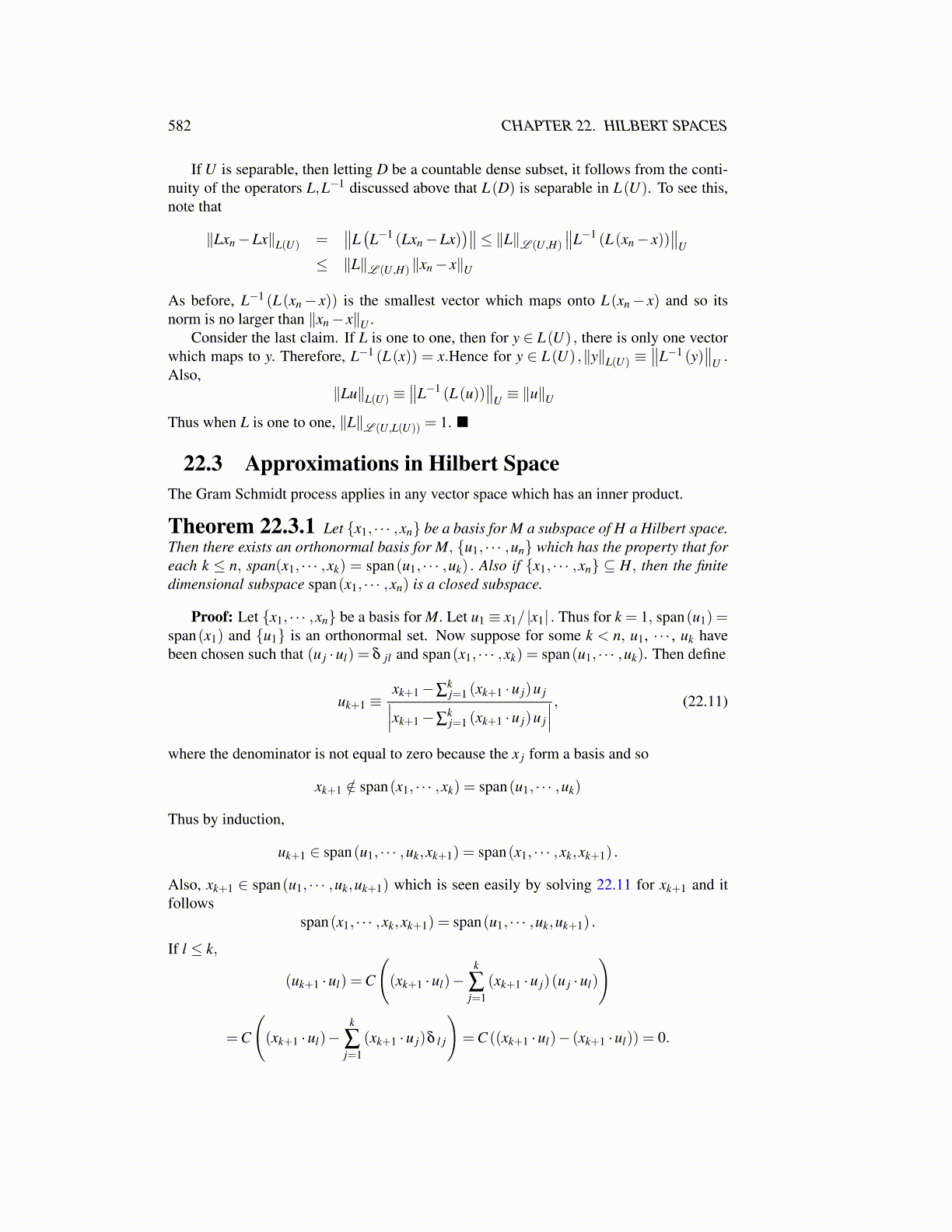
582 CHAPTER 22. HILBERT SPACES
If U is separable, then letting D be a countable dense subset, it follows from the conti-nuity of the operators L,L−1 discussed above that L(D) is separable in L(U). To see this,note that
∥Lxn−Lx∥L(U) =∥∥L(L−1 (Lxn−Lx)
)∥∥≤ ∥L∥L (U,H)
∥∥L−1 (L(xn− x))∥∥
U
≤ ∥L∥L (U,H) ∥xn− x∥U
As before, L−1 (L(xn− x)) is the smallest vector which maps onto L(xn− x) and so itsnorm is no larger than ∥xn− x∥U .
Consider the last claim. If L is one to one, then for y ∈ L(U) , there is only one vectorwhich maps to y. Therefore, L−1 (L(x)) = x.Hence for y ∈ L(U) ,∥y∥L(U) ≡
∥∥L−1 (y)∥∥
U .Also,
∥Lu∥L(U) ≡∥∥L−1 (L(u))
∥∥U ≡ ∥u∥U
Thus when L is one to one, ∥L∥L (U,L(U)) = 1. ■
22.3 Approximations in Hilbert SpaceThe Gram Schmidt process applies in any vector space which has an inner product.
Theorem 22.3.1 Let {x1, · · · ,xn} be a basis for M a subspace of H a Hilbert space.Then there exists an orthonormal basis for M, {u1, · · · ,un} which has the property that foreach k ≤ n, span(x1, · · · ,xk) = span(u1, · · · ,uk) . Also if {x1, · · · ,xn} ⊆ H, then the finitedimensional subspace span(x1, · · · ,xn) is a closed subspace.
Proof: Let {x1, · · · ,xn} be a basis for M. Let u1 ≡ x1/ |x1| . Thus for k = 1, span(u1) =span(x1) and {u1} is an orthonormal set. Now suppose for some k < n, u1, · · · , uk havebeen chosen such that (u j ·ul) = δ jl and span(x1, · · · ,xk) = span(u1, · · · ,uk). Then define
uk+1 ≡xk+1−∑
kj=1 (xk+1 ·u j)u j∣∣∣xk+1−∑kj=1 (xk+1 ·u j)u j
∣∣∣ , (22.11)
where the denominator is not equal to zero because the x j form a basis and so
xk+1 /∈ span(x1, · · · ,xk) = span(u1, · · · ,uk)
Thus by induction,
uk+1 ∈ span(u1, · · · ,uk,xk+1) = span(x1, · · · ,xk,xk+1) .
Also, xk+1 ∈ span(u1, · · · ,uk,uk+1) which is seen easily by solving 22.11 for xk+1 and itfollows
span(x1, · · · ,xk,xk+1) = span(u1, · · · ,uk,uk+1) .
If l ≤ k,
(uk+1 ·ul) =C
((xk+1 ·ul)−
k
∑j=1
(xk+1 ·u j)(u j ·ul)
)
=C
((xk+1 ·ul)−
k
∑j=1
(xk+1 ·u j)δ l j
)=C ((xk+1 ·ul)− (xk+1 ·ul)) = 0.